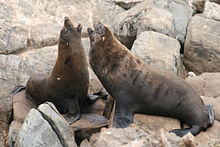New Zealand fur seal
| New Zealand fur seal | |
|---|---|
 |
|
| Scientific classification | |
| Kingdom: | Animalia |
| Phylum: | Chordata |
| Class: | Mammalia |
| Order: | Carnivora |
| Suborder: | Pinnipedia |
| Family: | Otariidae |
| Subfamily: | |
| Genus: | |
| Species: | A. forsteri |
| Binomial name | |
|
Arctocephalus forsteri Lesson, 1828 |
|
| Distribution of the New Zealand fur seal | |
Arctocephalus forsteri, the New Zealand fur seal, southern fur seal or long-nosed fur seal, is a species of fur seal found around the south coast of Australia, the coast of the South Island of New Zealand, and some of the small islands to the south and east of there. Male-only colonies are also located on the Cook Strait coast of the North Island near Wellington and vagrants are found as far north as New Caledonia. The name New Zealand fur seal is used by English speakers in New Zealand (kekeno is used in the Māori language), and southern fur seal by speakers in Australia. As of 2014, the common name long-nosed fur seal has been proposed for exclusive use within Australia. Although the two populations show some genetic differences, their morphologies are very similar, and thus they remain classed as a single species.
Although the seals look docile, they can move surprisingly quickly and it is advisable never to approach a female with young or get between a seal and the water, cutting off its escape route to the sea.
Males have been reported as large as 250 kg; their average weight is about 126 kg. Males can be 2 meters long. Females are between 30–50 kg on average, and can be as long as 1.5 meters. Pups are 3.3–3.9 kg on average, and between 40 and 55 cm long. At 290 days old males are about 14.1 kg, and females are about 12.6 kg. They have external ears and hind flippers that rotate forward, which visibly distinguish them from other seals. They have a pointy nose with long pale whiskers. The fur seals are covered by two layers of fur. The coat is grey-brown on their back, and lighter on their belly. Some have white tips on longer upper hairs, which can give them a silver-like appearance.
So called "Upland Seals" once found on Antipodes Islands and Macquarie Island have been claimed as a distinct subspecies with thicker furs by scientists although it is unclear whether these seals were genetically distinct.
New Zealand fur seals "porpoise" out of the water when traveling quickly at sea. They can dive deeper and longer than any other fur seal. Females can dive for about 9 minutes and to a depth of about 312 meters, and can dive deeper and longer in autumn and winter. Males can dive for about 15 minutes to a depth of about 380 meters. On average New Zealand fur seals only dive for 1–2 minutes. When they dive for food they dive deeper during the day but shallower at night, because during the day their prey typically migrates to deeper depths and migrates back up during the night.
...
Wikipedia

